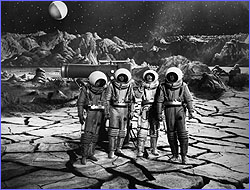
|
 |
 |
Movie attendance drops as television rapidly gains in popularity. To bring moviegoers back to the cinema, producers introduce effects-laden spectacles and larger-than-life film formats like Cinemascope, Todd-AO, VistaVision, and 3-D. 1950 George Pal produces "Destination Moon," a tale of lunar travel that snares the Oscar for effects and ushers in a decade of science fiction features with high-profile special effects. In addition to Pal's Oscar-winning "When Worlds Collide" (1951) and "War of the Worlds" (1953), audiences throng to "The Day the Earth Stood Still" (1951), "Forbidden Planet" (1956) and "Earth Vs. the Flying Saucers "(1956). 1956 Cecil B. DeMille tackles "The Ten Commandments" for the second time. The Red Sea parting is considerably more elaborate than the Jello slab of the 1923 version, involving a blue-screen Charlton Heston, miniatures, pyrotechnics, 600 extras, matte paintings, and a 32-foot high dam channeling tens of thousands of gallons of water. Insiders speculate that the gag cost about two and a half years and $2 million—the most expensive special effect to date. Continue: 1960s Photo: MOMA Reel Timeline | 50-Foot Chicken | Wizards of Ahs | Be in Pixels Titanic: What's Real | Virtual Humans | Resources | Teacher's Guide Transcript | Site Map | Special Effects Home Editor's Picks | Previous Sites | Join Us/E-mail | TV/Web Schedule About NOVA | Teachers | Site Map | Shop | Jobs | Search | To print PBS Online | NOVA Online | WGBH © | Updated November 2000 |
 Lunar set for "Destination Moon"
Lunar set for "Destination Moon"